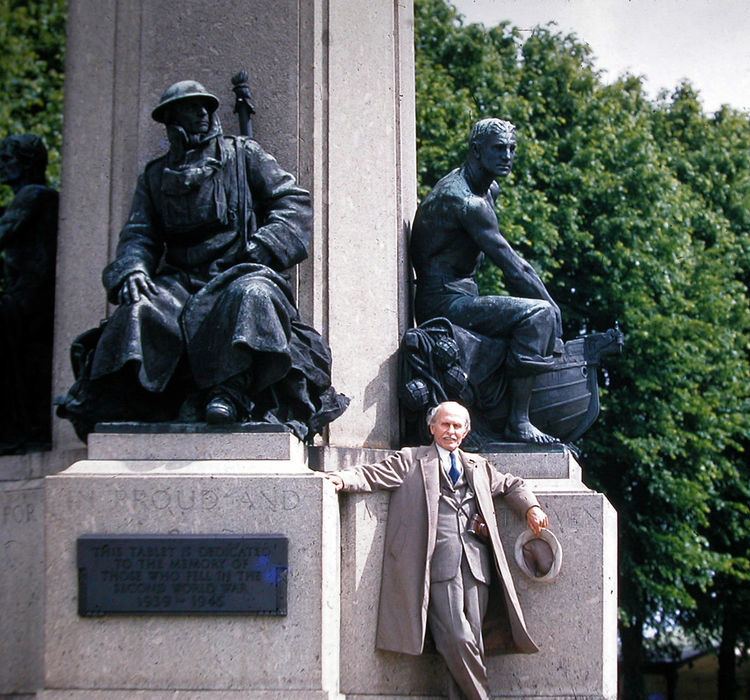Resting place Zoar Cemetery Occupation sculptor, lecturer Religion Episcopalian Name John Angel Died October 16, 1960 Children John Lawrence Angel | Residence Fairfield, Connecticut Known for sculpture Spouse(s) Elizabeth Day Seymour Role Sculptor Education Royal Academy of Arts | |
 | ||
Born November 1, 1881 Newton Abbot, Devon, England | ||
John Angel (November 1, 1881 – October 16, 1960) was a British-born sculptor, architectural and ecclesiastical sculptor, medallist and lecturer. He immigrated to the United States where he created architectural sculpture. His work in the United Kingdom and the United States has been critically praised.
Contents
Biography
He was born in Newton Abbot, Devon. Angel was the son of a tailor, and one of ten children. He entered a seven-year apprenticeship to a wood carver at the age of 14 years. He received formal training at the Exeter School of Art. His training continued at the Lambeth School of Art. George Frampton became his mentor at the Royal Academy School, and his influence resonated in Angel's work. Angel also studied with Sir Thomas Brock. His professional progression is verified by census data: his occupation in the Census of England and Wales, 1901 was; "Wood Carver – Appren[tice]" and in the 1911 census, "Sculptor". Turning 30, he was elected in 1919 to the Royal Society of British Sculptors.
His work in the United Kingdom includes the Exeter War Memorial and the Bridgwater War Memorial — also known as the "Angel of Bridgwater"
He was especially noted for evocative ecclesiastical sculptures. He spent many years doing the six bronze doors at St. Patrick's Cathedral in New York. He teamed with architect Ralph Adams Cram in outfitting Pittsburgh's East Liberty Presbyterian Church, colloquially known as the "Cathedral of Hope," and did the Last Supper group in marble as well as tympana over several entrances. The commissions and awards were numerous.
In 1930 he completed the Founder's Memorial at Rice University — depicting a seated William Marsh Rice — in line with specifications by architect Ralph Adams Cram.
He produced sculptures for chapels at Princeton University, St. Paul's School (Concord, New Hampshire) and the Desloge Hospital in St. Louis, Missouri.
A statue honoring Alexander Hamilton in Lincoln Park in Chicago, Illinois was mired in controversy, at least concerning the surrounding architecture. Kate Sturges Buckingham (1858–1937), of the Buckingham Fountain family, commissioned the monument. Its impetus was that Treasury Secretary Hamilton "secured the nation’s financial future and made it possible for her own family to make its fortune in grain elevators and banking." Consequently, John Angel was hired to model a figurative sculpture and the Finnish architect Eliel Saarinen was to create a "colossal architectural setting" for it. The proposed 80-foot tall columned shelter was poorly received. By Ms. Buckingham's death in 1937, the sculpture’s setting. location and design were uncertain. Conspiracy allegations surfaced, and the matter became mired in litigation. After the courts ordered the construction to be completed by 1953, the trustees hired architect Samuel A. Marx. It was built, but structural problems appeared, and it was eventually demolished in 1993. The statue was gilded, and is still on display.
Personal life
He resided in London and married Elizabeth Day Seymour (1876 Hudson, Ohio – January 6, 1942) on April 25, 1914 in London, England. They met in Greece at a time when he "was a promising young sculptor." Educated at Bryn Mawr, she became an American classicist. She was the daughter of Professor Thomas Day Seymour, of Yale University. They had two children. The family went to the United States in 1925, upon the request of architect Ralph Adams Cram. In his autobiography Cram was to write, "John Angel had come to America for a visit, and we had induced him, rather against his will I fancy, to do for us...Out of the blue, so to speak, had fallen upon us the very sculptor we had dreamed of but hardly dared hope for."
British-American biological anthropologist John Lawrence Angel (1915–1986) was Angel-Seymour's son.
Death and legacy
When he died in Fairfield, Connecticut, he was reputed to be one of America’s foremost sculptors; some considered him unrivaled for the times, comparing him to some of the finest sculptors of the Middle Ages. Two main works were at the Cathedral of Saint John the Divine in New York and in the George Rogers Clark National Historical Park in Vincennes, Indiana. The latter includes a rendering of Francis Vigo. Angel himself proclaimed the ten-ton Vigo sculpture to be probably the best he had ever done. He described the style of most of his work as ersatz 13th Century Gothic. But says Angel, "I use all my knowledge of the human figure, so what we call Gothic is Gothic with a difference." By nature self-deprecating, he noted: "I never went to school; I'm an ignoramus."
His and his wife Elizabeth's remains are interred at Zoar Cemetery, also known as Berkshire Cemetery, in Fairfield, Connecticut.
The Smithsonian Institution has 4.1 linear feet of his biographic material, books, sketches, 30 sketch books, photographs and papers, having been donated by Henry S. Angel in 1981. Elizabeth Day Seymour's papers are with her family's 51 linear feet on deposit at the Yale University Library.
